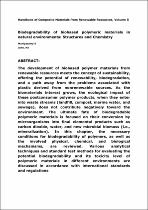 ResearchSpace
ResearchSpace
Biodegradability of biobased polymeric materials in natural environments: Structures and Chemistry
JavaScript is disabled for your browser. Some features of this site may not work without it.
- ResearchSpace
- →
- Research Publications/Outputs
- →
- Book Chapters
- →
- View Item
| dc.contributor.author |
Muniyasamy, Sudhakar

|
|
| dc.contributor.author |
John, Maya J

|
|
| dc.date.accessioned | 2017-06-15T06:25:23Z | |
| dc.date.available | 2017-06-15T06:25:23Z | |
| dc.date.issued | 2017-03 | |
| dc.identifier.citation | Muniyasamy, S. and John, M.J. 2017. In: Thakur, V.K., Thakur, M.K. and Kessler, M.R. (eds). Handbook of Composites from Renewable Materials, Volume 5, p. 625-653 | en_US |
| dc.identifier.isbn | 978-1-119-22379-5 | |
| dc.identifier.uri | http://eu.wiley.com/WileyCDA/WileyTitle/productCd-1119223792.html | |
| dc.identifier.uri | http://hdl.handle.net/10204/9268 | |
| dc.description | Copyright: 2017 Scrivener Publishing LLC. Due to copyright restrictions, the attached PDF file only contains the abstract of the full text item. For access to the full text item, kindly consult the publisher's website. | en_US |
| dc.description.abstract | The development of biobased polymer materials from renewable resources meets the concept of sustainability, offering the potential of renewability, biodegradation, and a path away from the problems associated with plastic derived from nonrenewable sources. As the biomaterials interest grows, the ecological impact of these postconsumer polymer products, when they enter into waste streams (landfill, compost, marine water, and sewage), does not contribute negatively toward the environment. The ultimate fate of biodegradable polymeric materials is focused on their conversion by microorganisms into final elemental products such as carbon dioxide, water, and new microbial biomass (i.e., mineralization). In this chapter, the necessary conditions for biodegradability of polymers, as well as the involved physical, chemical, and biological mechanisms, are reviewed. Various analytical techniques and standard test methods for evaluating the potential biodegradability and its toxicity level of polymeric materials in different environments are discussed in accordance with international standards and regulations. | en_US |
| dc.language.iso | en | en_US |
| dc.publisher | Scrivener Publishing LLC | en_US |
| dc.relation.ispartofseries | Worklist;18415 | |
| dc.subject | Biobased polymers | en_US |
| dc.subject | Biocomposites | en_US |
| dc.subject | Biodegradation | en_US |
| dc.subject | Composting | en_US |
| dc.title | Biodegradability of biobased polymeric materials in natural environments: Structures and Chemistry | en_US |
| dc.type | Book Chapter | en_US |
| dc.identifier.apacitation | Muniyasamy, S., & John, M. J. (2017). Biodegradability of biobased polymeric materials in natural environments: Structures and Chemistry., <i>Worklist;18415</i> Scrivener Publishing LLC. http://hdl.handle.net/10204/9268 | en_ZA |
| dc.identifier.chicagocitation | Muniyasamy, Sudhakar, and Maya J John. "Biodegradability of biobased polymeric materials in natural environments: Structures and Chemistry" In <i>WORKLIST;18415</i>, n.p.: Scrivener Publishing LLC. 2017. http://hdl.handle.net/10204/9268. | en_ZA |
| dc.identifier.vancouvercitation | Muniyasamy S, John MJ. Biodegradability of biobased polymeric materials in natural environments: Structures and Chemistry.. Worklist;18415. [place unknown]: Scrivener Publishing LLC; 2017. [cited yyyy month dd]. http://hdl.handle.net/10204/9268. | en_ZA |
| dc.identifier.ris | TY - Book Chapter AU - Muniyasamy, Sudhakar AU - John, Maya J AB - The development of biobased polymer materials from renewable resources meets the concept of sustainability, offering the potential of renewability, biodegradation, and a path away from the problems associated with plastic derived from nonrenewable sources. As the biomaterials interest grows, the ecological impact of these postconsumer polymer products, when they enter into waste streams (landfill, compost, marine water, and sewage), does not contribute negatively toward the environment. The ultimate fate of biodegradable polymeric materials is focused on their conversion by microorganisms into final elemental products such as carbon dioxide, water, and new microbial biomass (i.e., mineralization). In this chapter, the necessary conditions for biodegradability of polymers, as well as the involved physical, chemical, and biological mechanisms, are reviewed. Various analytical techniques and standard test methods for evaluating the potential biodegradability and its toxicity level of polymeric materials in different environments are discussed in accordance with international standards and regulations. DA - 2017-03 DB - ResearchSpace DP - CSIR KW - Biobased polymers KW - Biocomposites KW - Biodegradation KW - Composting LK - https://researchspace.csir.co.za PY - 2017 SM - 978-1-119-22379-5 T1 - Biodegradability of biobased polymeric materials in natural environments: Structures and Chemistry TI - Biodegradability of biobased polymeric materials in natural environments: Structures and Chemistry UR - http://hdl.handle.net/10204/9268 ER - | en_ZA |





